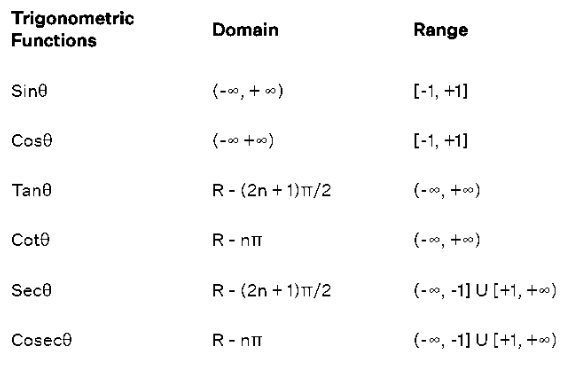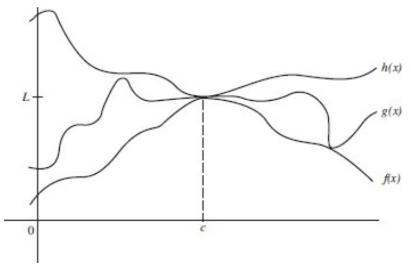Barron's AP Calc AB+BC Flashcards (Units 1 - 5)
1/48
Earn XP
Description and Tags
Deck Includes: - Key Formulae - Basic Derivatives + Rules for taking Derivatives - Basic Integrals + Rules for taking Anti-Derivatives (more will be added as I progress through the book)
Name | Mastery | Learn | Test | Matching | Spaced |
|---|
No study sessions yet.
49 Terms
Unit 1: Functions
Precalc Review of Properties of:
Rational Functions
Trig/Inverse Trig Functions
Exponential/Logarithmic Functions
Parametric Functions (BC)
Polar Curves (BC)
Even Function
f(-x) = -f(x)
Odd Function
f(-x) = f(x)
Rational Function
f(x) = \frac{p(x)}{q(x)}
(Domain: set of all real # where q(x) \neq 0 )
(Range: (-\infty, +\infty) )
State the Domain and Range for all Trig Functions

State the Domain and Range for all Inverse Trig Functions

Exponential Functions
f(x) = a^x (a>0, a\neq 1)
Logarithmic Function
y=\log_ax IF AND ONLY IF a^y=x
Write down all the log properties you remember
\log_a1=0
\log_aa=1
log_a a^m = m
\log_amn=\log_am+\log_an (Product Rule)
\log_a\frac{m}{n} = \log_am-\log_an (Quotient Rule)
\log_ax^m=m\log_ax (Exponent Rule)
\log_mn=\frac{\log_an}{\log_am} (Change of Base Rule)
Parametric Equation
x=f(t), y=g(t) where t is the parameter
Polar Function
r=f(\theta)
(very broad def.)
Write down all the types of polar functions you remember (BC)
Spiral: r=\theta
Rose Curve: r= k \cdot sin(m \cdot \theta) or r = k \cdot cos(m \cdot \theta)
Limacons: r= k + m \cdot sin(\theta) or r= k + m \cdot cos (\theta) -
Dimpled Limacons: k>m
Cardioid: k=m
Limacon w/Inner Loop: k<m
Unit 2: Limits and Continuity
general properties of limits
how to find limits
horizontal and vertical asymptotes
continuity
types of discontinuities (removable, jump, infinite)
Squeeze Theorem
Extreme Value Theorem
Intermediate Value Theorem
Limit and One-Sided Limit
\lim_{x \to c} f(x) = L
(as x approaches c, f(x) = L )
\lim_{x \to c^+} f(x) = L or \lim_{x \to c^-} f(x) = L
(as x approaches c from the left or right, f(x)=L )
Horizontal Asymptote and Vertical Asymptote
\lim_{x \to \pm \infty}f(x)=b
(horizontal asymptote)
\lim_{x \to a}f(x)=\pm \infty OR \lim_{x \to a^ \pm} f(x) = \pm \infty
(vertical asymptote)
Write down all the properties of limits you remember
if \lim f(x) and \lim g(x) are finite numbers (not going to \pm \infty ), then
\lim k \cdot f(x) = k \cdot \lim f(x)
\lim [f(x) + g(x)] = \lim f(x) \cdot \lim g(x)
\lim (f(x) \cdot g(x)) = \lim f(x) \cdot \lim g(x)
\lim {\frac {f(x)}{g(x)}} = \frac{\lim f(x)}{\lim g(x)}
\lim_{x \to k} = k
Sandwich (Squeeze) Theorem
if f(x) \ge g(x) \ge h(x) AND
if \lim_{x \to c} = \lim_{x \to c}=L,
then lim_{x \to c} = L

Rational Function Theorem
if the degree of p(x) < q(x), then \lim_{x \to \pm \infty} \frac{p(x)}{q(x)}= 0
(horizontal asymptote)if the degree of p(x) = q(x), then \lim_{x \to \pm \infty} \frac{p(x)}{q(x)}= \frac{a_p}{b_q} , where a and b are the coefficients of the highest powers
(horizontal asymptote)if the degree of p(x) > q(x), then \lim_{x \to \pm \infty} \frac{p(x)}{q(x)}= \pm \infty (vertical asymptote/DNE)
What is the limit of sin \theta?
\lim_{x \to \theta} \frac {sin \theta}{\theta} = 1
(if \theta is in rads)
Continuous
f(a) exists
\lim_{x \to a} f(x) exists
\lim_{x \to a} f(x) = f(a)
Define the three types of discontinuities
Removable Discontinuity: \lim_{x \to a} f(x) AND f(a) exists, but \lim_{x \to a} f(x) \ne f(a)
Jump Discontinuity: \lim_{x \to a^+} f(x) \ne \lim_{x \to a^-} f(x)
Infinite Discontinuity: \lim_{x \to a^-} f(x) = \pm \infty
Extreme Value Theorem
if f is continuous in [a, b], then f has a min and max value in that interval
Intermediate Value Theorem
if f is continuous in [a, b], and f(a) \le m \le f(b), then there is at least one number d in [a, b] that f(d) = m
if f(a) and f(b) have opposite signs then there is a value d in [a, b] where f(d) = 0.
Continuous Function Theorem
if f(x) and g(x) are both continuous at x=c, the following will also be continuous:
k \cdot f(x)
f(x) \pm g(x)
f(x) \cdot g(x)
\frac{f(x)}{g(x)}, if g(x) \neq 0
Unit 3: Differentiation
definitions of derivatives
estimating derivatives
derivatives of basic functions
product, quotient, chain rules
implicit differentiation
Rolle’s Theorem
Mean Value Theorem
L’Hopital’s Rule
derivatives of parametric functions (BC)
Derivative
\lim_{\Delta x \to 0} \frac{f(x+\Delta x)-f(x)}{\Delta x}, often notated as f’(x), y’, \frac{dy}{dx}, or D_xy
Difference Quotient
\frac{f(a+h)-f(a)}{h}
Represents the avg. rate of change from a to a+h.
Symmetric Difference Quotient
f’(a) \simeq \frac{f(a+h)-f(a-h)}{2h}
Derivatives of Constants and Coefficients
(a and n are constants and u and v are differentiable functions of x)
\frac{da}{dx}=0
\frac{d}{dx}au=a\frac{du}{dx}
Chain Rule
\frac{dy}{du} \cdot \frac{du}{dx}
“Take the derivative of the “outside” function w/the “inside” function left the same, then multiply by the derivative of the “inside” one”
^^very important concept, make sure you understand!
Power Rule
(a and n are constants and u and v are differentiable functions of x)
\frac{d}{dx}u^a=au^{a-1}\frac{du}{dx}
Addition and Subtraction Rules
(a and n are constants and u and v are differentiable functions of x)
\frac{d}{dx}(u+v)=\frac{d}{dx}u+\frac{d}{dx}v
\frac{d}{dx}(u-v)=\frac{d}{dx}u-\frac{d}{dx}v
Product Rule
(a and n are constants and u and v are differentiable functions of x)
\frac{d}{dx}(u \cdot v)=u \frac{dv}{dx}+v \frac{du}{dx}
Quotient Rule
\frac{d}{dx}(\frac{u}{v})=\frac{{v \frac{du}{dx}}-u \frac{du}{dx}}{v²}, (v \neq 0)
Sine and Cosine Derivatives
(a and n are constants and u and v are differentiable functions of x)
\frac{d}{dx} \sin u = \cos u \frac{d}{dx}
\frac{d}{dx} \cos u = -\sin u \frac{d}{dx}
Tangent and Cotangent Derivatives
(a and n are constants and u and v are differentiable functions of x)
\frac{d}{dx} \tan u = \sec²u \frac{du}{dx}
\frac{d}{dx} \cot u = -\csc²u \frac{du}{dx}
Secant and Cosecant Derivatives
(a and n are constants and u and v are differentiable functions of x)
\frac{d}{dx} \sec u = \sec u \tan u \frac{du}{dx}
\frac{d}{dx} \csc u = -\csc u \cot u \frac{du}{dx}
Exponent and Natural Log Derivatives
(a and n are constants and u and v are differentiable functions of x)
\frac{d}{dx}a^u = a^u \ln a \frac{du}{dx}
\frac{d}{dx} e^u = e^u \frac{du}{dx}
\frac{d}{dx} \ln u = \frac{1}{u} \cdot \frac{du}{dx}
Arcsin and Arccos Derivatives
(a and n are constants and u and v are differentiable functions of x)
\frac{d}{dx} \sin^{-1}u = \frac{1}{\sqrt{1-u²}} \cdot \frac{du}{dx}, (-1<u<1)
\frac{d}{dx} \cos^{-1}u= -\frac{1}{\sqrt{1-u²}}, (-1<u<1)
Arctan and Arccot Derivatives
(a and n are constants and u and v are differentiable functions of x)
\frac{d}{dx} \tan^{-1}u = \frac{1}{1+u²} \cdot \frac{du}{dx}
\frac{d}{dx} \cot^{-1}u = -\frac{1}{1+u²} \cdot \frac{du}{dx}
Arcsec and Arccsc Derivatives
(a and n are constants and u and v are differentiable functions of x)
\frac{d}{dx} \sec^{-1}u = \frac{1}{|u| \sqrt{u²-1}} \cdot \frac{du}{dx}, (|u|>1)
\frac{d}{dx} \csc^{-1}u = -\frac{1}{|u| \sqrt{u²-1}} \cdot \frac{du}{dx}, (|u|>1)
What is the relationship between differentiability and continuity?
“Differentiability implies continuity, but continuity does not imply differentiability”
Parametric First Derivative (BC)v
\frac{dy}{dx} = \frac{\frac{dy}{dt}}{\frac{dx}{dt}} where t is the parameter
Parametric Second Derivative (BC)
\frac{d²y}{dx²} = \frac{d}{dx}(\frac{dy}{dx}) = \frac{\frac{d}{dt}(\frac{dy}{dx})}{\frac{dx}{dt}}
Unit 4: Applications of Differential Calculus
slopes of curves/eqs. of tangent lines
maxima, minima, points of inflections
increasing, decreasing, concave up and down
motion along a line
local linear approximations
related rates
slope of parametric and polar curves (BC)
motion along parametrically defined curves (BC)
Slope of a curve
slope of the tanget to the curve at point (x_1, y_1) is f’(x) at x=x_1
Critical Point
f’(a)=0 or f’(a)= undefined
if f has a derivative everywhere, solve f’(x)=0
Equation of the tangent to a curve
(curve =y=f(x) at point P(x_1, y_1)) is:
y-y_1=f’(x_1)(x-x_1)
if the tangent is horizontal at a point, then the derivative = 0 (no slope=no rate of change=no derivative)
if the tangent is vertical at a point, then the derivative does not exist
Tangents to Parametrically Defined Curves